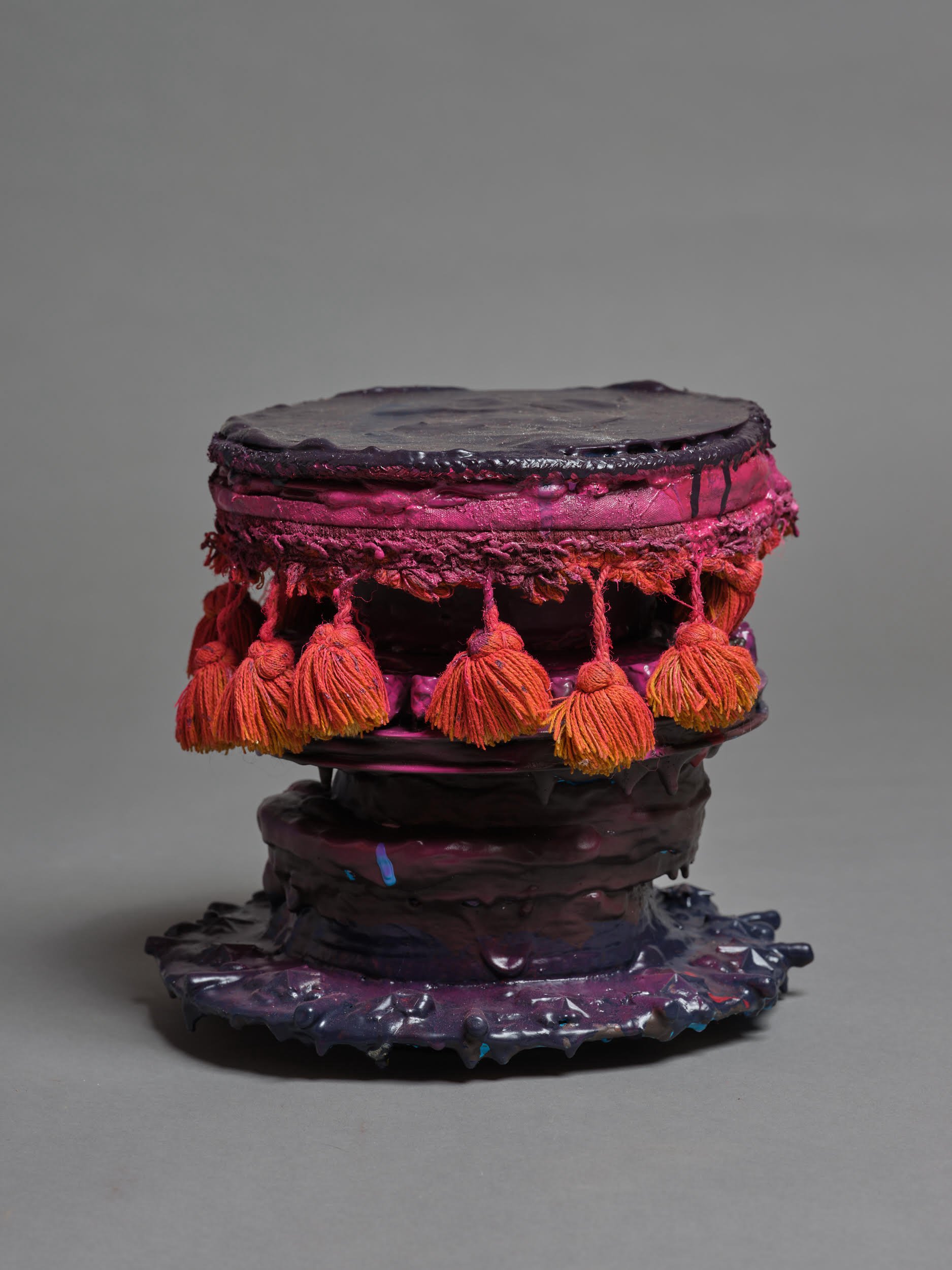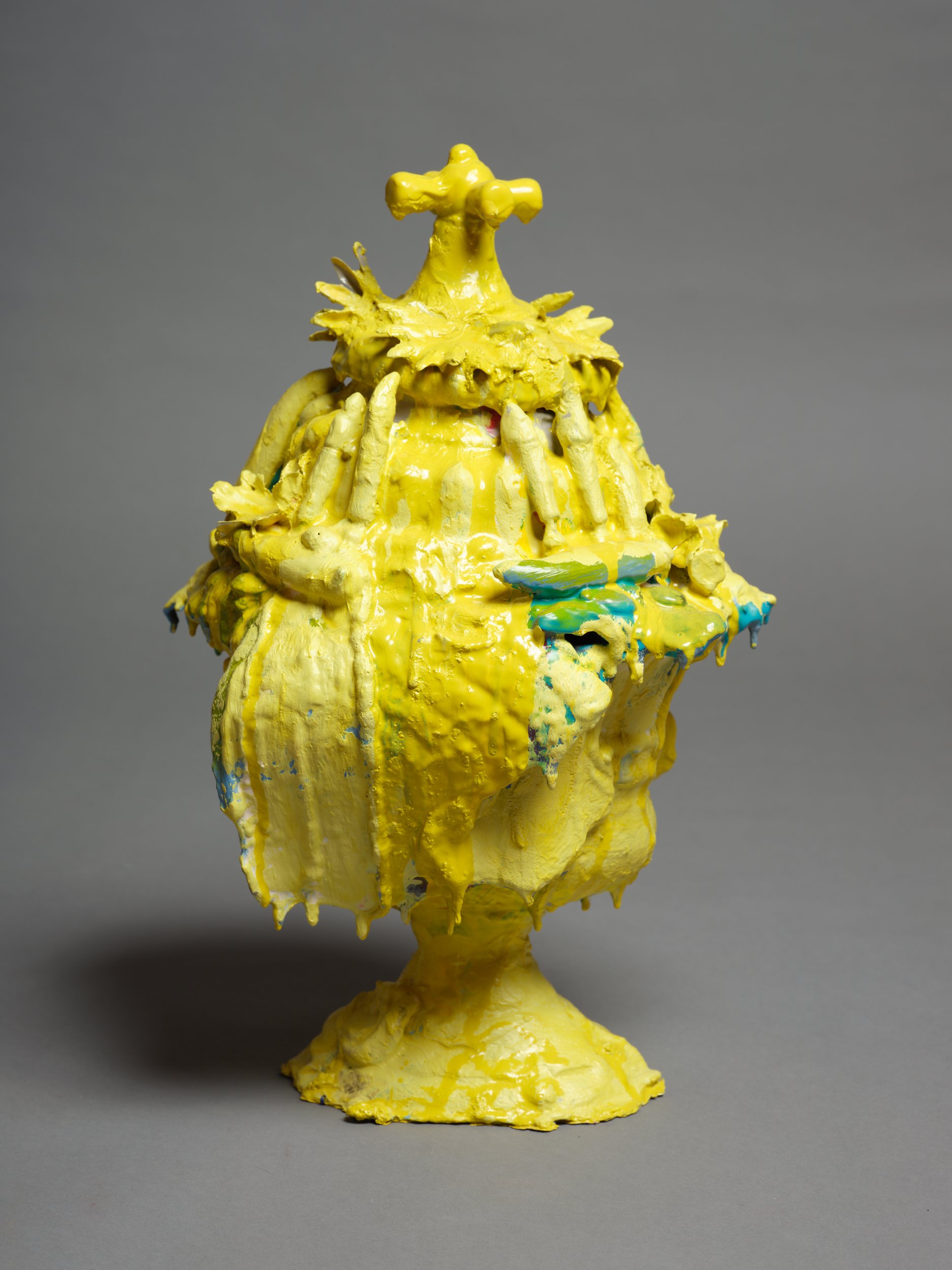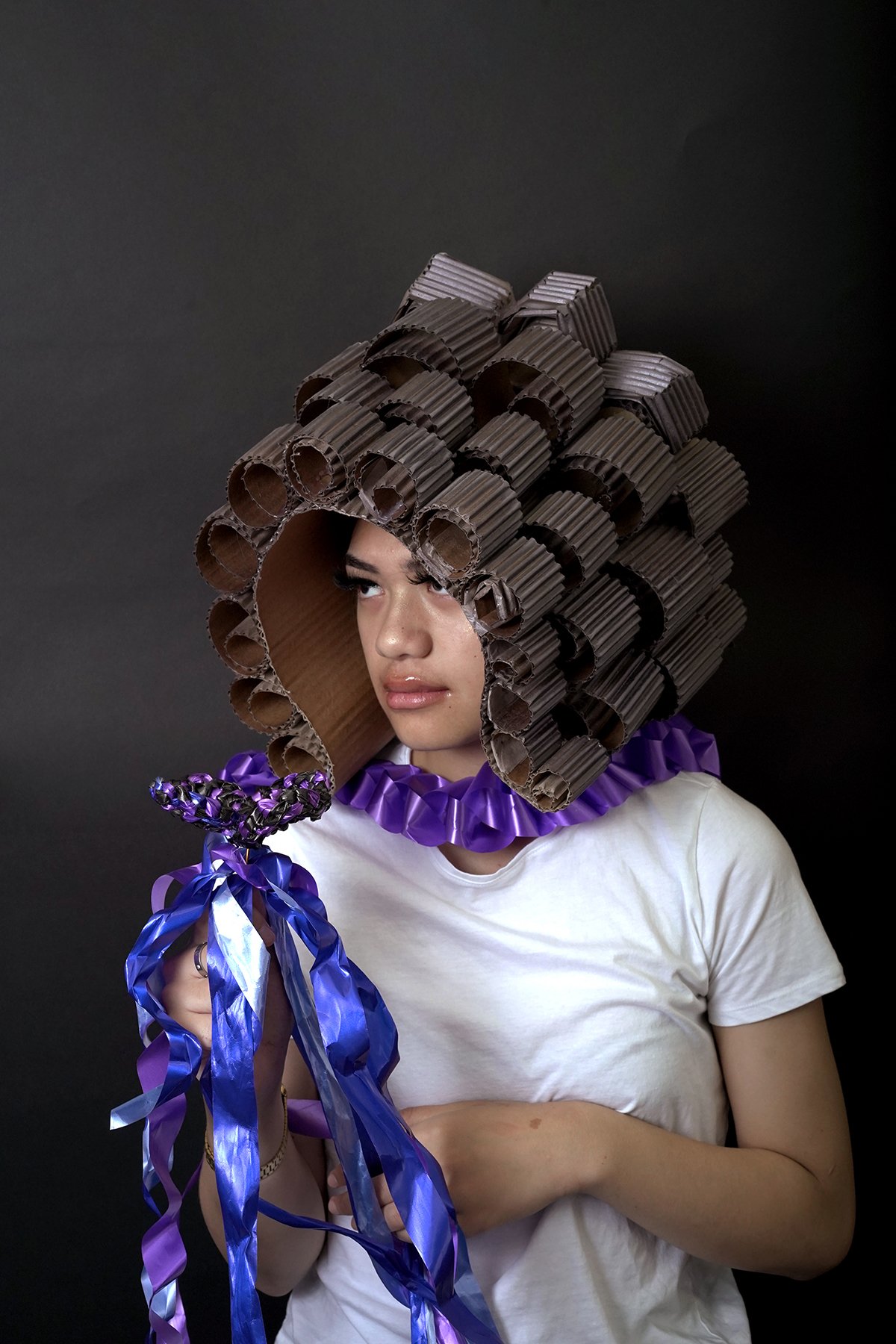Cake By The Ocean
Lachlan Taylor on Cat Fooks—commissioned by Anna Miles and Ramp Gallery on the occasion of Fooks’ exhibition at Ramp Gallery, Cake By The Ocean.
Cat Fooks, Pony Tail Palm, 2022, enamel and mixed media, 70 x 55 x 44 cm. Courtesy of the artist and Anna Miles. Gallery Photo: Sam Hartnett
Cat Fooks, Minnow, 2022, enamel and mixed media, 38 x 36 x 20 cm. Courtesy of the artist and Anna Miles Galley. Photo: Sam Hartnett
I have this terrifically ugly cake stand in my kitchen. It sits, unused, on top of the microwave covered in a gossamer veil of dust and the occasional dead fly. The base—a girthy ceramic stump that swoops into a flat platter—is a bilious green like an unwrapped lime Fruit Burst. The lid—also ceramic, over-sized to house vertically ambitious baked goods—is in that colour Crayola once ignorantly and indignantly called flesh. I’ve never used it. The peach and pea cake stand has never been home to a blueberry muffin or a tan slice. It just sits on my microwave with its dust and flies, waiting for something.
I found the stand on the side of the road early last year, sharing a Hataitai verge with a loose collection of other stuff. The accumulated curb-side matter, warm to the touch under late-summer sun, was all so much suburban jetsam: bits of board and metal, a railing, plastic and glass in sundry shapes with no discernible use. The only thing that legitimated what would otherwise be seen as a roadside trash pile was a single sheet of A4 refill, fixed to a low concrete wall that separated the verge from a rye-grass lawn. Someone had hastily scribbled FREE in pencil on the piece of paper. They’d taken part in a marginally illicit, frequently frowned upon, and yet constantly repeated weekend ritual that attempts to change and transform the status of the domestic unwanted—the impossible elevation of rubbish into boundless potential.
Here's a sweeping assertion I’m entirely unqualified to make: I think the curb-side giveaway is a bulwark against a psychic suburban fear. It keeps us from confronting the extent to which our lives are built around the accumulation and expulsion of rubbish and our participation in a culture of throwaway excess. But is this ever much more than a deferral, an extended detour on the way to the tip? These items have already been abandoned, already lost whatever patina of care and ownership they once held. Now they line up like orphans on the sidewalk hoping for a new home, but I think we all know where most are going to end up.
Cat Fooks makes art from things. Things like my cake stand. But also lamps, vases, urns, side tables, and writing desks. Often they’re things she’s found left on the side of the road under signs marked FREE. Or they’ve come to her in other ways, as gifts or heirlooms. And she makes art from other artworks too, objects generated and gestated in her Onehunga studio that never graduated to the status of exhibitable art object. All of these things, these various part-objects—the constituent elements of a Fooks’ work—are brought together, collaged, messily and almost violently into finished artworks.
Cat Fooks, Miss America (reverse view), 2022, enamel and mixed media, 93 x 91 x 61 cm
The assembled ingredients read like an I Spy riddle book sans the rhyming scheme. Let’s take just one. The armature of Miss America (2022) is an upturned writing desk—specifically a school desk used by Fooks’ uncle in Adelaide in the 1960s. Attached to the sides and top, and in a void formed by fixing a swing door to the recess intended for a chair, are a number of her ‘failed paintings’—two-dimensional projects which couldn’t be resolved into finished works. And then there are paint-tin lids, bed posts, parts of other tables, a standard lamp, LPs, a multitude of swirling and studded shapes in air dry clay, and the handle from a child’s bucket. She’s added castors the bottom (or top) of the desk too—Miss America is mobile.
But even such an expansive list of materials is only ever half of what goes into Fooks’ art, and the least visible half at that. Her creations, in two dimensions or three, are primarily defined by paint. Paint isn’t just a finish, the glossy aesthetic atop the real sculpture. It’s part of the binding of each work. It seeps between the assembled objects, filling every gap and empty space. Fooks insulates and upholsters her sculptures with layers of variegated dripping liquid. Through paint, they become joyful, playful, bold, and sickly sweet, ugly as all hell and yet arrestingly beautiful altars of colour. And her paints are as heterogenous as the materials they enfold. On and in Miss America there are enamel house paints, acrylics, enamacryl, and spray paint. And like the objects they cover, they too have come to Fooks from an array of odd sources: gifts, giveaways, and mistints.
There are precedents at play. Robert Rauschenberg, Tomoko Takahashi, maybe even a little Lynda Benglis. If you wanted to get art-academic about it, Fooks’ practice could best be called bricolage, a notion that entered the English-speaking artworld through translations of Claude Levi-Strauss in the 1960s. The French anthropologist used his adaptation from the root verb bricoler—to putter, tinker—to describe a process of creating something new from materials at hand. The term found popularity in discussion of post-modern practices, where the fractured construction of identity and representation fit well with the improvisational and circumscribed nature of the bricoleur. It’s the same root that gives us bric-à-brac, that odd signifier of bourgeois collectibles up the chain of object hierarchy from kitsch but still a step removed from ‘serious’ art. Etymological depths reveal more. In the late-Middle Ages, before bricoler became to tinker, it was to zig zag, to bounce off. And even that early verb has a deeper source. As a noun, bricole originally referred to a kind of medieval siege engine which hurled rocks like a trebuchet. That meaning survives in several sports’ vocabularies, usually describing some kind of ricochet manoeuvre.
What all these sources share, and what makes bringing them into view of interest, is a sense of awkward otherness and a shared status as a tangent, an alternative, perhaps even a mistake. Objects given the bric treatment are gently othered, somehow lesser in their status to the rest of the things that surround our lives. What are we to make of these objects, of the secondhand things we vainly hope might find a second home? Too good for the dump, too shabby for the op-shop. Fooks’ art isn’t an advertisement for upcycling or regeneration, a call for renewed use. She just wants us to look at this cast of weirded things—bedazzled, pulled apart, recombined, and drowned in paint. In her hands, these objects demand our attention again. Which is why bricolage, coming from the ivory tower as it does, is the perfect adjective for her work. Because Fooks’ objects and even her paints, the things she has welcomed into the orbit of her practice, are other objects, domestic ricochets.
Cat Fooks, Frog's Buttons, 2022, enamel and mixed media, 21 x 20 x 20 cm.
Cat Fooks, Lolli Bionda, 2022, enamel and mixed media, 30 x 24 x 24 cm. Courtesy of the artist and Anna Miles Gallery. Photo: Sam Hartnett
Cat Fooks, Hogback Island, 2022, oil and mixed media, 50 x 18 x 18 cm. Courtesy of the artist and Anna Miles Gallery. Photo: Sam Hartnett
Cat Fooks, Kobold, 2022, enamel and mixed media, 61 x 30 x 30 cm. Courtesy of the artist and Anna Miles Gallery. Photo: Sam Hartnett
Cat Fooks, Picotee, 2022, enamel and mixed media, 43 x 25 x 23 cm. Courtesy of the artist and Anna Miles Gallery. Photo: Sam Hartnett
Cat Fooks, Miss America, 2022, enamel and mixed media, 93 x 91 x 61 cm. Courtesy of the artist and Anna Miles Gallery. Photo: Sam Hartnett
Cat Fooks, Pony Tail Palm, 2022, enamel and mixed media, 70 x 55 x 44 cm. Courtesy of the artist and Anna Miles. Gallery Photo: Sam Hartnett
Cat Fooks, Pony Tail Palm (detail), 2022, enamel and mixed media, 70 x 55 x 44 cm. Courtesy of the artist and Anna Miles. Gallery Photo: Sam Hartnett
Cat Fooks, Minnow (reverse view), 2022, enamel and mixed media, 38 x 36 x 20 cm. Courtesy of the artist and Anna Miles Galley. Photo: Sam Hartnett
Cake By The Ocean runs at Ramp Gallery through 2 September 2022.

















Commissioned by Sarjeant Art Gallery Te Whare o Rehua Whanganui and republished on the occasion of du Chatenier’s exhibition Elephant’s Ear at Anna Miles Gallery, through 3 November 2022.